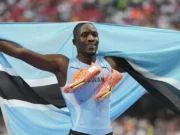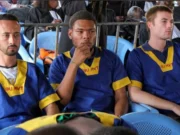By Ken Bediako
The Black Stars goalless affair with The Super Eagles last Friday really confirms the notion that history does repeat itself in football. As it’s well known, a similar situation occurred 20 years ago when coach Jones Atuquayefio hurriedly assembled a Hearts of Oak dominated Black Stars who fought a goalless draw with Nigeria in Accra. The second leg was a disastrous 3-0 defeat to Ghana but this is where I expect a big departure this time round in the second leg in Abuja tomorrow.
This current blend of hurriedly assembled Black Stars put up such a surprisingly spectacular performance that not even the most fastidious critic of the team would rate them inferior to the Eagles.
The entire squad played with unity of purpose and the packed to capacity Baba Yara Stadium gave them a fitting applause throughout the game. There were a few lapses that showed they had not been together for long but there was enough evidence that this could be a trenchant Black Stars group in the not too distant future. The thick crowd reminiscent of the 1983 champions league final between local idols Asante Kotoko and El Ahly of Egypt created an electric atmosphere under the refurbished floodlights. For the first time in living memory, the packed stadium enthusiastically sang the national anthem so lovely it might have awoken from the grave, the great football icon, Baba Yara, who is named after the stadium. Incidentally, the eve of the match March 24, was exactly 59 years ago in 1963 when Baba Yara was involved in a highway motor accident that suddenly cut off his colourful football career. He remained in a wheel chair and died six years later on May 5, 1969.
I may have to digress here and talk more about this immortal Baba Yara for I suspect more than half of the thick crowd at the Baba Yara stadium may have little or no knowledge about the legendary football artist famously known in his hey days as the king of wingers.
Baba Yara was one of the most outstanding and fascinating footballers in the country and could score easily with either foot. He was Kumasi Asante Kotoko’s star player and featured for the Black Stars for nearly eight years. Indeed, he scored two goals in Ghana’s historic 7-0 victory over Nigeria in the then annual challenge Jalco Cup at Accra Stadium in 1955.
On the local scene, Baba Yara was famous for scoring in every Kotoko match against traditional rivals, Hearts of Oak. He was cast in the mould of modern-day Super star Cristiano Ronaldo in height, physique and good looks. Fast and full of stylish tricks and a good passer of the ball, he inspired his team mates to several victories when the going was getting tough.
The only difference between Baba Yara and Ronaldo may be that unlike the flamboyant Ronaldo, Yara was a bit reserved off the pitch.
Football historians recall with nostalgia the dramatic way he led Asante Kotoko to overturn a 2-0 deficit to beat Accra Hearts of Oak 4-2 in the first FA Cp final in 1958 at Accra Stadium. This remains one of the richest legacies of his football legacy.
Kotoko were down 2-1 at half time. But soon on resumption Baba Yara inspired Kotoko with a brilliant equaliser from the penalty spot and assisted in two rapid goals to win the cup for Kotoko.
Born in Kintampo on Oct 12, 1936, Baba (Osumanu) Yara showed a flair for sports in general quite early in life and was a champion sprinter in an Arabic school in Kumasi.
At the age of 13, he displayed signs of a talented footballer but his love for games generally drew him to horse racing.
Between 1950-53 he was a jockey at the Accra Turf Club and played football as well.
He returned to Kumasi in 1954 and played regularly for Asante Kotoko as a top star until 1961 when he was recruited by Sports Director Ohene Djan for the newly formed star packed novelty national model club, Ghana Real Republikans.
As already mentioned, his colourful football career ended suddenly in 1963 at age 27 following a serious spine injury he sustained in a terrible highway motor accident on March 24 1963 at Kpeve in the Volta Region. He was returning from a victorious league match at Kpandu over the local Mulpos with his club mates in Republikans. Twelve other players received slight injuries in the accident.
Baba Yara was flown to the UK the following day to the famous Stoke Mandeville Hospital accompanied by Dr R.O Addae, surgical specialist at the 37 Military hospital.
Initial reports said there was the possibility of Baba Yara gaining a reasonable recovery within a period of four to six months. This was not to happen.
Baba Yara was flown to Accra on August 14. He led a quiet life in a government bungalow in Accra and died peacefully on May 5 1969.
He was buried at Odorkor cemetery where I witnessed for the first time in my life Muslim burial. Simplicity at its zenith.
He left behind his wife ,pretty fair coloured Patience and two-year old daughter Yasmin.
In 2004, the then minister in charge of sports, Mr Kwadwo Baah Wiredu, set up a committee to recognise outstanding sports personalities in Ghana. Headed by Dr Owusu Ansah of the sports ministry and including yours truly, one of our many recommendations was to name the Kumasi Stadium after Baba Yara.
The stadium was originally built by the United Africa Company (UAC) in 1959 as a donation to the people of Ashanti in appreciation of their high cocoa production in the country. UAC was a major cocoa buying agency.
This Baba Yara stadium is a fitting memorial for one of the greatest footballers Ghana has ever produced. The venue is fast proving to be the citadel of football in the country. It is hoped the new Black Stars would gain a lot of inspiration from the genuine support they had on Friday and go all out to win the day. It’s a tough assignment though, but if they put up a little more team effort than they showed in the first leg, Qatar will welcome them with broad smiles.
Cheers everybody and keep loving sports.










































